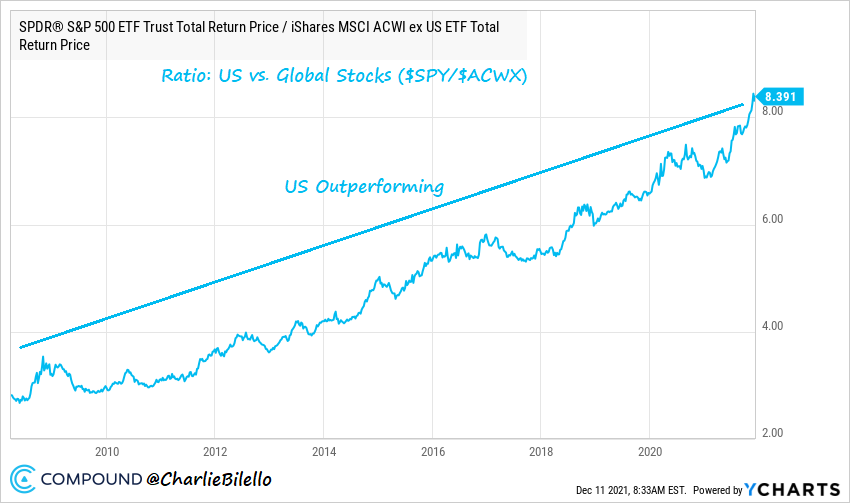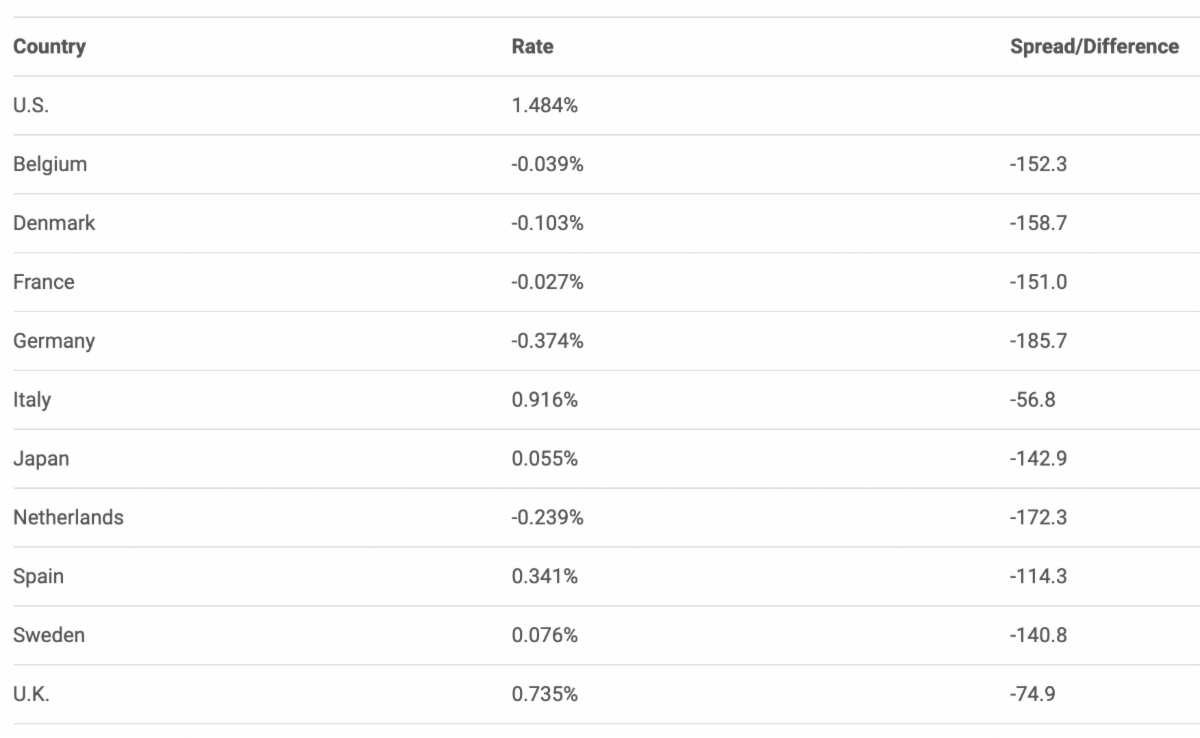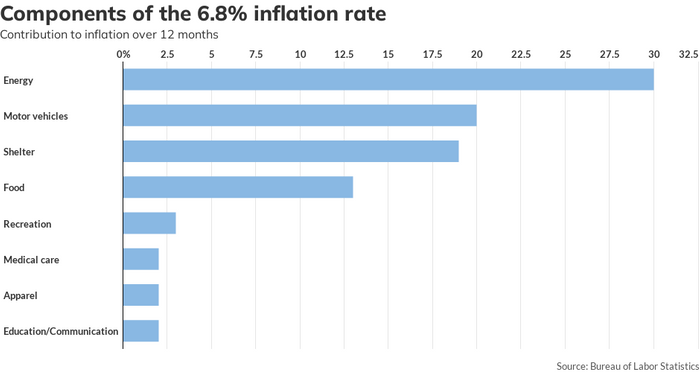1.Massive Performance of Top 5 Market Cap Stocks in S&P
“The S&P 5“ No that’s not a typo, this chart shows the “S&P 5“ — i.e. the top 5 stocks (…what it looks like if you just held the top 5 stocks: rebalancing monthly). Funnily enough it looks like the top 5 stocks are up 5 x over the past 5 years

Source: @MichaelKantro From Callum Thomas Weekly Chart Storm
2.U.S. Leads Again-10 Years of Outperformance vs. International with Spread Widening in 2021
@Charlie BilelloUS stocks are once again besting most of their global peers, up 27.1% year-to-date versus a 6.8% gain for the average country ETF.

The incredible run of outperformance by the US is now more than a decade long…

3.One Reason U.S. Rates Stay Low—U.S. Rates vs. International…Spread/Difference
On My Radar-CMG Wealth.
|

|
https://www.cmgwealth.com/ri/
4.Another Look at Margin Debt…..Vs. Free Cash Balances
Zerohedge-One way to look at “leverage,” as it relates to the financial markets, is through “margin debt,” and in particular, the level of “free cash” investors have to deploy. So, for example, in periods of “high speculation,” investors are likely to be levered (borrow money) to invest, which leaves them with “negative” cash balances.

5.Asset Classes and Correlation to Inflation

From Barry Ritholtz The Big Picture Blog
https://ritholtz.com/2021/12/
6.Four items in the family budget Contributing the Most to Inflation
Over the past 12 months, prices have risen 6.8%, the largest gain since 1982. The bulk of the gains have been in four big items in the typical family’s budget: Energy, shelter, vehicles and food. These four items represent about 61% of consumer purchases, but account for 81% of the inflation we’ve experienced over the past 12 months.
Gas, trucks, housing and food account for the vast majority of price increases over the past year

This chart shows the contribution of each item to inflation recorded over the past 12 months. Energy goods and services, for example, accounted for 30% of the total price increases.
MARKETWATCH
7.Rapid Rise of Shein Shopping App with Gen Z Shoppers

|
8.Housing Affordability Index—Hot Areas Like Nashville, Houston, and Phoenix Still Affordable.
John Burns Real Estate This chart shows the % of income the median income household would need to afford the median-priced home in an area.
While our clients in Nashville, Houston and Phoenix bemoan how expensive those areas have become, they still look really cheap to people willing to relocate there
https://www.linkedin.com/in/

9.Social Media Consumer Fraud Sees Dramatic Growth During Pandemic
Philadelphia Inquirer

https://www.inquirer.com/business/facebook-instagram-online-shopping-scam-fake-stamps-20211212.html
10.8 Hidden Health Effects of Chronic Stress
Physical reactions to upsetting times are not uncommon.
KEY POINTS- ANDREA BONIOR PH.D.
- Anecdotally, many medical providers report increased cases of things like dizziness and tooth grinding as people suffer higher stress levels.
- Stress can lead to hair loss, often because the stress response pushes follicles into the resting phase.
- During times of prolonged stress, muscles may maintain a state of hypervigilance, leading to soreness.
The mental health toll of the COVID-19 pandemic has led to increased awareness about just how important emotional wellness is — and how easily it can suffer during times of sustained stress. As depression and anxietyrates rise, more people are talking openly about their struggles with mood, which can lead to more people seeking help.
What is not always part of the discussion in this context, however, is the physical toll that stress can take on the body. We may be very familiar with weight gain and sleep problems, but less aware that certain new physical ailments we are experiencing may be exacerbated by —or even originate from — a prolonged stress response. Anecdotally, many medical providers from ENTs to dentists are reporting increased cases of things like dizziness and tooth grinding, respectively, as people suffer from higher stress levels than usual.
Are you suffering from any of the symptoms below? It is always best to start with a full medical workup from a general practitioner, but it is also important to understand the role that stress can play.
1. Dental problems
From the deterioration that comes from tooth grinding to increased jaw pain and muscle tension, and tooth decay that stems from a change in eating patterns, dentists often see reactions to stress in ways that many patients may miss in themselves.
Has teleworking made you snack around the clock, leading to cavities? Has not getting dressed for work mean you brush your teeth less frequently? Has your partner reported that you seem to be grinding your teeth at night? These subtle changes can add up to real damage, so it’s important to pay attention.
2. Rashes and acne
Our skin can be considered our largest organ, and it functions practically as a canvas of what is going on with our bodies in the general sense. As our hygiene habits change, so too may our skincare routine — leading to pimples or overly dry, unmoisturized skin. Stress can cause flare-ups of eczema or even hives, creating itching that can add cruelly to your distress — beginning the cycle anew.
3. Hair loss
Stress can lead to hair loss in both females and males, often because the stress response itself pushes follicles into the resting phase. So, hairs are prone to falling out simultaneously instead of alternating, leading to potentially large clumps of hair being lost at the same time.
Another way that hair loss can be stress-related is through our behavior. We may twist and pull our hair due to nervous energy, sometimes even without realizing it. Other times, if daily hygiene and hair-brushing fall by the wayside due to emotional duress, tangles and matted clumps can be created that end up pulling out massive amounts of hair when they are finally combed.
4. Sore muscles
Muscle tension and anxiety are practically synonymous, so very interwoven into the stress response is the tightening that happens from your temples to your toes. So, during times of prolonged stress, when these muscles are constantly maintaining a state of hypervigilance without a chance to loosen, your body may feel completely beaten down, like you have run a marathon — or even gotten into a fistfight.
5. Frequent colds
The relationship between the immune system and the stress response is well-documented. And while for the past year we have been focused on the deadly threat of COVID-19, there are many additional viruses and pathogens that spread with contact.
When you experience prolonged stress, your immune system works less than optimally. Moreover, the potential behavioral ripple effects of stressfultimes, like poor sleep and not eating well, can make you more rundown, weaken your immune system, and make you more likely to get sick as well.
6. Dizziness
If you are experiencing frequent bouts of dizziness, it’s important to get checked out by a physician to rule out various physiological issues. Nonetheless, there could be many stress-related reasons for the dizziness, from changes in posture and neck alignment to changes in diet that lead to inadequate vitamins and minerals.
In medicine, we are learning more and more that everything is connected — and though dizziness might not immediately seem to be connected to (for example), your longer, flustered days at the computer, it could very well be. From eyestrain to misalignment that causes neck pressure that affects your inner ear, many things are related that are not obvious at first glance.
7. Digestive problems
A “nervous stomach” has become a common descriptor for a reason: Stress affects all kinds of aspects of your stomach and intestine function. The threat response of fight-or-flight typically halts digestion (your body believes at that moment it has more important things to deal with), which means that your lunch may be left sitting in a pool of stomach acid. Stress also often affects our diets and our levels of physical activity. All told, from nausea and heartburn to diarrhea and constipation, it’s common for changes in this area of function to be at least partly attributable to stress.